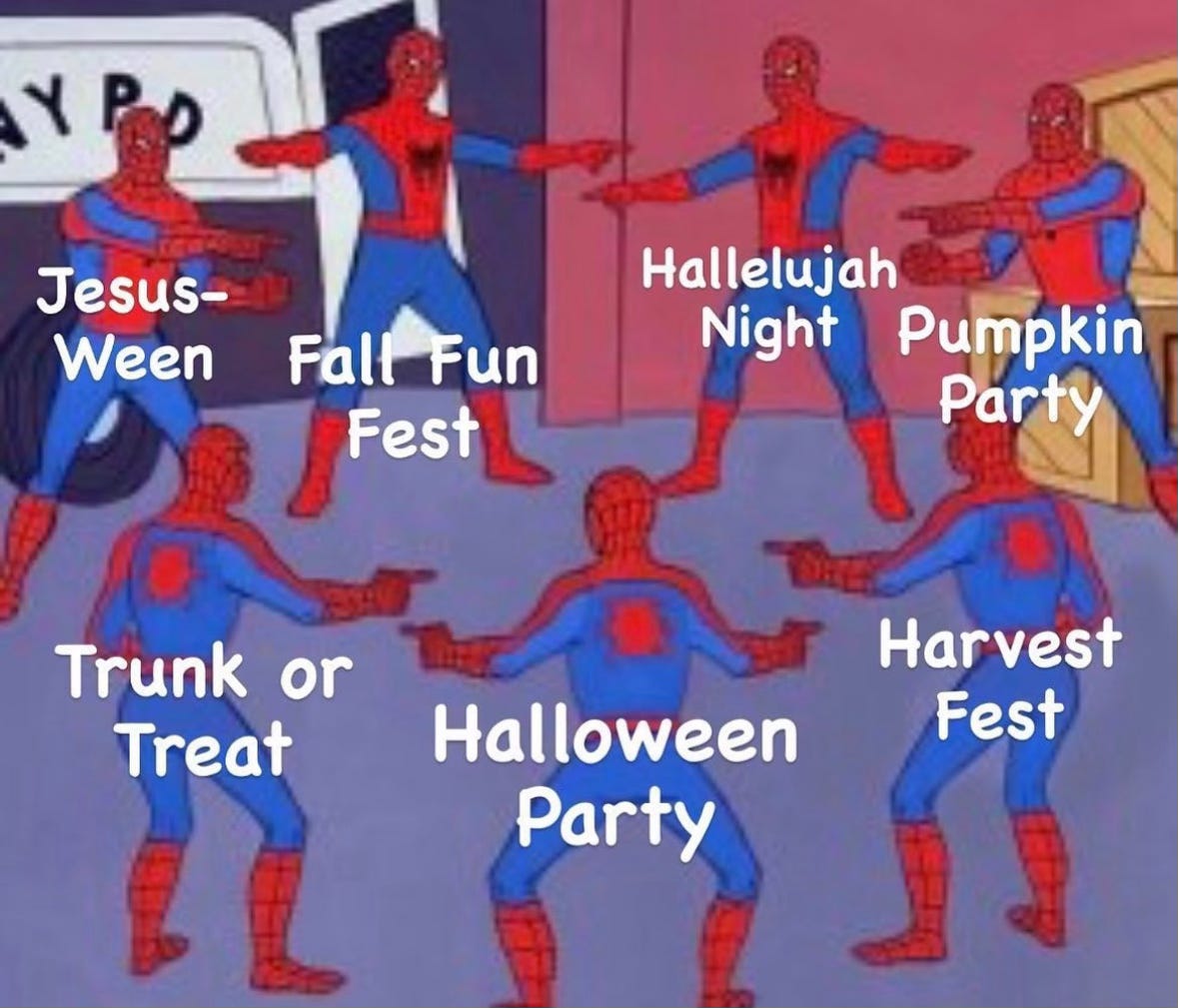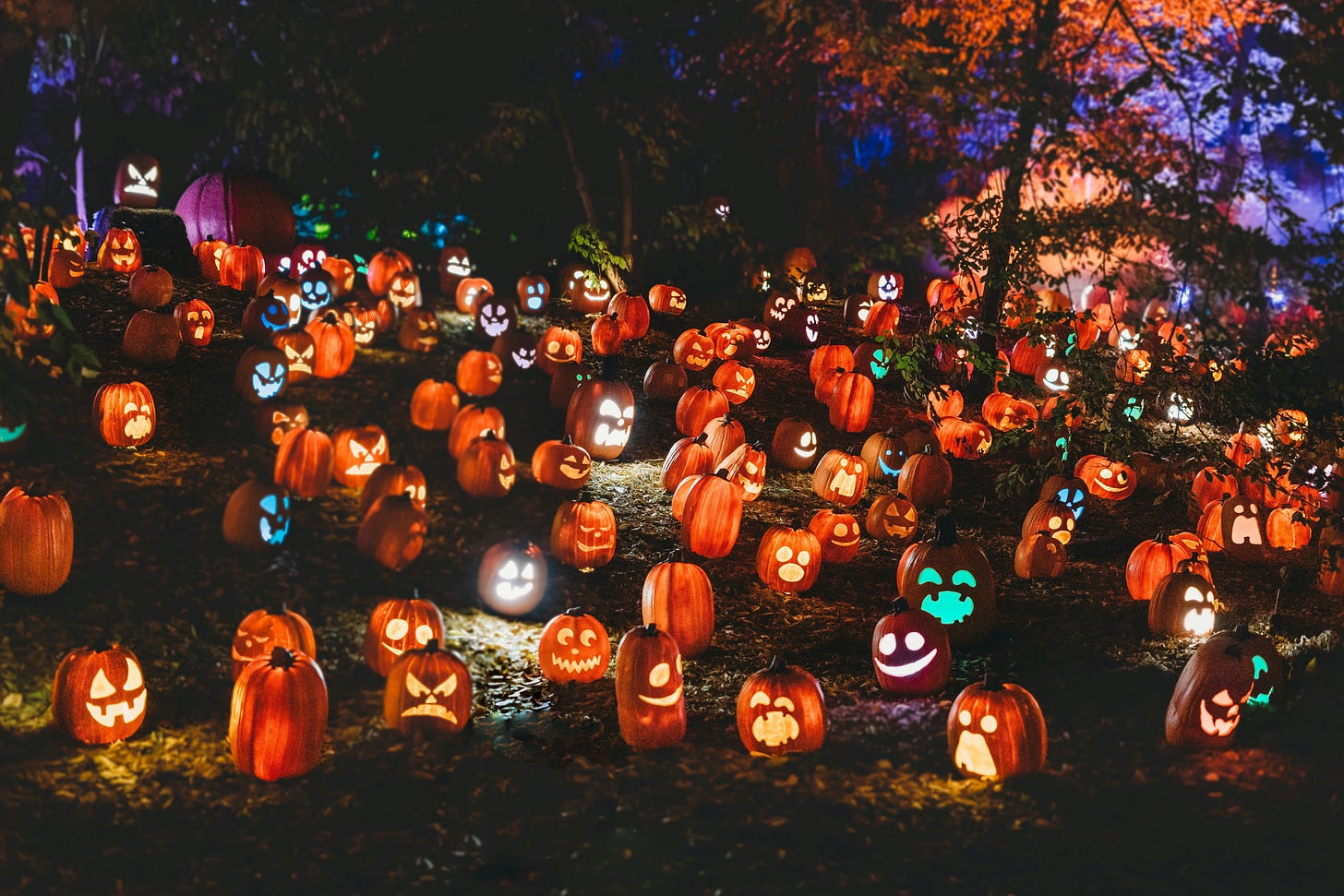Holy Ghosts
Costumes, Candy, and Church History: The True Story of Halloween
Picture this: it’s October 2002, I’m ten years old, and excited to wear my new Clemson football costume to the Fall Festival at our church. Our church, like many of yours, didn’t “celebrate” Halloween. In rebellion to the “devil’s holiday,” we did a Fall Festival. A few things that marked this defiant event were:
Kids wearing costumes.
Kids bringing buckets to go around to different cars (we’ll say doors) to get candy when they say, “Trick-or-Treat!”
Hay rides through a dark wood where deacons hid in ditches to jump out and scare congregants.
Pumpkin carving.
(One year) a haunted house that would scare the hell—literally—out of people. The pastor was waiting at the end of the path through the haunted house to give an invitation: “If you were to die tonight, would you want to live through this forever? No? Then, ask Jesus into your heart.” We had hundreds “get saved” that year and, frankly, never saw them again.
If all of this sounds familiar, it’s because it is.
Origins of Halloween
Halloween, believe it or not, originates in the Church. What was originally called All Hallows’ Eve began as a Christian vigil before All Saints’ Day, observed on November 1, and All Souls’ Day on November 2. The three days together are traditionally known as Allhallowtide, a time dedicated to remembering saints, martyrs, and all souls of the faithful who have departed. Though today’s American Halloween customs have broadly diverged from their liturgical context, the roots of the holiday remain firmly planted in the Church’s historical story.
Christians have, from the earliest centuries, frequently set aside times to honor martyrs and saints, especially in light of persecution. As early as the 4th century, we have record of St. Ephrem of Edessa in a hymn mentioning a feast to All Martyrs.1 St. John Chrysostom preached a sermon in the 5th century on “all the Saints who suffered martyrdom throughout the world.”2 These older celebrations often followed Easter or Pentecost—Chrysostom’s sermon likely was a post-Pentecost All Saints commemoration. The tendency, and need, to celebrate the faithful who had gone before was ever-present within early Christianity, independent of any pagan holidays.
In the Western Church, All Saints’ Day took form in the early Middle Ages. In the 8th century, Pope Gregory III dedicated a chapel at St. Peter’s Basilica to all saints, and some accounts place this occurrence on November 1. Over the following century, observance of All Saints on November 1 spread. By 835 A.D., Emperor Louis the Pious, highly influenced by Pope Gregory IV, issued a decree making November 1 the official Feast of All Saints throughout the Carolingian Empire.
Liturgically,3 All Hallows’ Eve is the evening vigil (on October 31) that precedes All Saints’ Day. Major Christian feasts begin with a vigil the prior evening (think of Christmas Eve preceding Christmas). The vigil includes evening prayers or a Mass to celebrate the Feast. All Hallows’ Eve is a sacred time of reflection on the souls who have departed. Medieval England sometimes referred to All Hallows’ Day, indicating the evening (of October 31) and day (of November 1) were liturgically connected as part of one holy observance.
Reformation Day
Interestingly, October 31 is also Reformation Day—a day when Martin Luther nailed his 95 Theses to the door of the Wittenberg church in 1517. Many scholars agree that Luther chose October 31 because crowds would attend Mass the following morning to celebrate All Saints’ Day. Because of the connection between October 31 and the Reformation, Protestant Europe—which became Protestant America—lost touch with the original role of October 31, as many Protestants celebrate Reformation Day in place of Halloween, or All Hallows’ Eve.
However, in many traditions, All Hallows’ Eve remains intact. For example, in the Episcopal Church’s Book of Occasional Services, there is an official liturgy for All Hallows’ Eve (October 31). During this service, Scripture is read, such as The Witch of Endor in 1 Samuel 28:3-25, The Vision of Eliphaz the Temanite in Job 4:12-21, The Valley of Dry Bones in Ezekiel 37:1-14, and The War in Heaven in Revelation 12:(1-6)7-12. The liturgy opens with this note:
This service may be used on the evening of October 31, known as All Hallows’ Eve. Suitable festivities and entertainments may take place before or after this service, and a visit may be made to a cemetery or burial place.4
The liturgy offers prayers throughout that acknowledge the reality of evil and death but also celebrate Christ’s triumph over darkness.
In a sense, our dressing up in costumes and making light of evil and death is a way of affirming Satan’s defeat—rather than something we fear, we make fun of it.
In the 10th-15th centuries, Christians in parts of Britain and Ireland observed Hallowtide (another word for Allhallowtide) through a custom called souling. On All Hallows’ Eve, poor children would go door-to-door offering prayers for the dead in exchange for small cakes, called soul cakes. This was deeply Christian: giving and receiving of alms and goods centered on a Church holiday.
Furthermore, Ronald Hutton notes, “The wearing of disguises at Hallowe’en first appears in Scotland in the sixteenth century… a custom related to guising and to the Christian feast of All Hallows rather than any pagan rite.”5
Halloween in Contemporary America
The fundamental transformation of Halloween began with the arrival of Irish and Scottish immigrants in America in the 19th century. These immigrants brought their Halloween folk customs to a Protestant America with little to no established liturgical connection to All Hallows’ Eve. Outside of Catholic tradition and communities, Halloween was virtually unknown to Americans.
Irish and Scottish immigrants came to America during the Great Irish Famine of the 1840s. During the famine, children and youths went out “guising” on Halloween, carving lanterns from turnips or pumpkins and begging for apples, nuts, or coins, while in costumes. As these families immigrated to America, this tradition caught hold and rapidly grew in popularity. By the 1930s, trick-or-treating had become a widespread tradition that continued to evolve into the activity we participate in today. Large corporations took advantage of this popularity, and Halloween is now one of the most lucrative holidays for big-box stores.
Almost all of our current Halloween practices are less than a century old. Yet, the connection to the ancient Church celebration of saints and souls remains. Attempts to connect Halloween to cultic festivals, such as the popular Samhain, are historically disjointed. Historian Nicholas Rogers concludes, “[Samhain] did not offer much in the way of actual ritual practices… Most of these developed in conjunction with the medieval holy days of All Souls’ and All Saints’ Day.”6
What Are We to Do, Then, With Halloween?
In my opinion? Have fun!
Martin Luther said, often quoted by C.S. Lewis, “The best way to drive out the devil, if he will not yield to texts of Scripture, is to jeer and flout him, for he cannot bear scorn.” If you want to take a more liturgical approach to it, one commentator writes, “All Hallows’ Eve is a time for reflecting on our mortal state, for acknowledging our natural fear of mortality…and for remembering the various monsters and spooks that have given concrete shape to these fears across the centuries.”7
What decorations and images do you see around Halloween? Skeletons, tombstones, etc. While some take it too far, these images originate in Church History as a time to recognize death as a very real thing that Christ has overcome. Halloween is a moment to begin acknowledging those who have gone before us—some giving their life for the kingdom of Jesus. The association of Halloween with the demonic is mainly attributed to modern horror films and books, not to historical reality. Historical truth will always remain the essence of a life formed by Christ, his story, and being fully alive—and a life a lot less religiously rigid.
I did NOT write this to tell you that you must celebrate Halloween with 30-foot skeletons in your yard; I wanted to provide a historical perspective in an otherwise misunderstood season.
So, here’s to eating so many pieces of candy that we eat lettuce and broccoli for weeks!
Saunders, William. “Halloween and All Saints Day.” Arlington Catholic Herald, Oct 28, 2004
Saunders, “Halloween and All Saints Day.”
Liturgy is the tradition of worship for the Christian Church.
The Book of Occasional Services, (Church Publishing: New York, 2022), p. 141-43.
Ronald Hutton, Stations of the Sun, p. 367.
Rogers, Nicholas. Halloween: From Pagan Ritual to Party Night. New York: Oxford University Press, 2002, pp. 14-23.
National Catholic Register, (31 October 2016).





